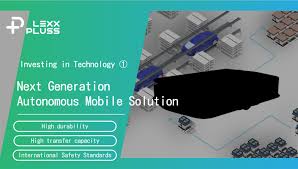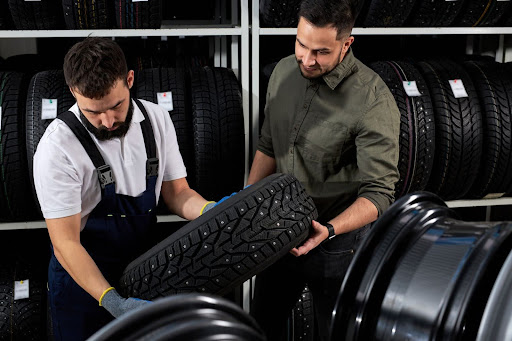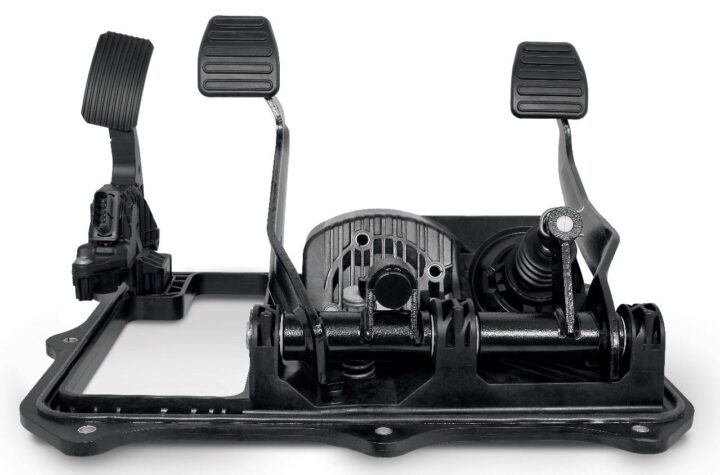
Automotive Industries recently had the privilege of engaging in an enlightening conversation with Sandeep Chilukuri, the esteemed Project Manager at LexxPluss. With nearly a decade of expertise in this pivotal role, Sandeep offered invaluable insights into LexxPluss’s ambitious expansion endeavors in the US market and the intricate challenges and strategies involved in seamlessly integrating autonomous mobile robots (AMRs) into the automotive and manufacturing infrastructures.
Sandeep’s pivotal role at LexxPluss entails close collaboration with multifarious teams including Engineering, Sales, Quality, and Compliance, ensuring the seamless delivery of projects to customers. He emphasized the significance of adeptly managing scope creep, change management, and issue handling during projects, accentuating the imperative need to bolster AMR performance based on discernments gleaned from customer interactions.
LexxPluss’s foray into the US market unfurls several challenges in harmonizing AMR technology with extant infrastructures. Sandeep elucidated on the dynamic and intricate environments AMRs must adeptly navigate, alongside the evolving compliance standards. He underscored LexxPluss’s unwavering focus on system interoperability and scalability to surmount these hurdles, ensuring a smooth integration process and offering adaptable solutions to customers.
System interoperability and scalability stand as the linchpins of LexxPluss’s AMR solutions. Sandeep delineated specific methodologies employed by the company, encompassing standards compliance, data interoperability, and rigorous pre-integration testing, all aimed at seamlessly integrating AMRs into diverse automotive manufacturing facilities.
The Lexx500 AMR’s remarkable capability to handle payloads of up to 500 kg profoundly impacts the efficiency and productivity of automotive logistics operations. Sandeep expounded on how the versatility, augmented throughput, direct delivery to assembly lines, space optimization, and diminished manual labor afforded by mid-sized AMRs like the Lexx500 contribute to operational enhancements.
Safety remains paramount for LexxPluss, with multi-sensor safety features ensuring secure navigation in dynamic environments. Sandeep expounded on sensor fusion, intelligent software analysis, and the comprehensive safety features infused into LexxPluss’s AMRs to operate harmoniously alongside individuals in automotive manufacturing environments.
To ensure the triumphant deployment and adoption of LexxPluss AMRs, Sandeep outlined a comprehensive approach encompassing collaborative pre-deployment planning, rigorous testing and commissioning, phased implementation for scalability, seamless system integration, and post-deployment support and feedback mechanisms.
The inauguration of the US demo space proffers potential automotive industry partners firsthand exposure to LexxPluss solutions, enabling them to gauge the technology’s prowess and suitability for their unique requisites. Sandeep accentuated the personalized approach undertaken during demonstrations to address each customer’s pain points and prerequisites.
LexxPluss’s rebranding endeavor endeavors to spotlight its avant-garde capabilities and instill trust within the US market, catalyzing the adoption of its AMR solutions. Looking ahead, LexxPluss aspires to achieve substantial market penetration and emerge as a distinguished industry leader within the US automotive sector through strategic partnerships and technological innovations.
Automotive Industries interview with Sandeep Chilukuri, Project Manager, LexxPluss
Automotive Industries: Hi Sandeep, can you tell us about your role as Project Manager at LexxPluss and how it ties into the company’s expansion efforts in the US?
Chilukuri: Hey there. Thanks for reaching out and giving me an opportunity to introduce myself and LexxPluss.
I have been with LexxPluss as PM for nearly 10 months now. I work closely with the Engineering, Sales, Quality, and Compliance teams at LexxPluss to deliver successful projects to customers. During the project, I make sure all scope creep, change management, and issue handling are managed effectively. My regular interactions with customers and System integrators during projects enable me to gain knowledge about challenges at customer sites. By acquiring information from these projects, I was able to work with the Engineering team to help build robust hardware and software capabilities, thereby enhancing our AMR’s performance.
Automotive Industries: With LexxPluss investing heavily in the US market, what are the main challenges you foresee in terms of integrating your autonomous mobile robots (AMR) technology into existing automotive and manufacturing infrastructures?
Chilukuri: Absolutely. When deploying AMRs in real-world settings, we understand there are several key challenges. These include:
- Dynamic and complex environments: AMRs need to navigate environments that can change frequently, with factors like changing layouts, unpredictable traffic patterns, uneven terrain, and potential network connectivity issues.
- Evolving compliance standards: Our AMRs must adhere to regulatory requirements that can change over time.
We prioritize overcoming these challenges by focusing on two critical areas:
- System interoperability: We design our AMRs to seamlessly integrate with existing systems and infrastructure, regardless of manufacturer. This ensures a smooth deployment process and avoids compatibility issues. Using API’s for efficient integration with customer systems.
- Scalability: Our solutions are designed to be scalable. This allows customers to easily adapt their AMR deployments as their needs evolve and their operations grow.
By addressing these challenges head-on, we ensure our AMRs deliver reliable performance and long-term value for our customers.
Automotive Industries: LexxPluss emphasizes the importance of interoperability and scalability in its solutions. How do you ensure that your AMRs can seamlessly integrate with diverse systems already in place within automotive manufacturing facilities?
Chilukuri: Absolutely, system interoperability and scalability are the cornerstone of our AMR solutions. Here are some specific methods we employ to achieve this:
- Standards Compliance: We prioritize ensuring our devices meet relevant US industry standards. This lays the groundwork for compatibility with existing systems used by our customers.
- Data Interoperability: Our AMRs are designed to access and exchange data seamlessly with Manufacturing Execution Systems (MES) and Warehouse Management Systems (WMS) used in many facilities. This fosters a more collaborative and efficient workflow.
- Scalability through APIs: We leverage Application Programming Interfaces (APIs) to enable scalability for our AMR deployments. This allows customers to easily integrate additional AMRs into their operations as their needs grow.
- Rigorous Pre-Integration Testing: We conduct comprehensive pre-integration testing at our Indiana facility to identify and address any potential compatibility issues before deployment at customer sites. This minimizes downtime and ensures a smooth integration process.
- Operator Training: We provide thorough operator training programs to ensure users understand how to effectively interact with our AMRs and leverage their integration capabilities.
Automotive Industries: The Lexx500 AMR is designed to handle payloads of up to 500 kg. How does this capability impact the efficiency and productivity of automotive logistics operations?
Chilukuri: Absolutely, mid-sized AMRs like ours offer a compelling value proposition for a variety of industries.
Our primary target is to Automate processes that could not be automated by conventional AGV’s. In addition to
- Versatility: Our AMRs can handle a wide range of loads, from automotive parts and materials to finished products and even pallets. This versatility allows companies to streamline their internal logistics with a single AMR solution.
- Increased Throughput with Fewer Robots: The efficient nature of AMRs enables companies to manage their throughput using fewer robots compared to traditional methods. This translates to cost savings and a smaller footprint.
- Direct Delivery to Assembly Lines: AMRs eliminate unnecessary transportation steps by delivering parts directly to assembly lines. This reduces congestion and improves production efficiency.
- Space Optimization: By automating material handling tasks and eliminating the need for manual staging areas, our AMRs help companies utilize their floor space more efficiently. Using our interfaces such as LexxTug and LexxHub customers can avoid significant changes to their existing material handling equipment and system devices. This can be a game-changer, particularly in facilities with limited space.
- Reduced Manual Labor: AMRs take over repetitive and potentially hazardous manual material handling tasks. This frees up employees to focus on higher-value activities and contributes to a safer work environment.
In essence, mid-sized AMRs offer a powerful combination of versatility, efficiency, and space optimization, making them a transformative tool for businesses across various industries.
Automotive Industries: LexxPluss has been recognized for its multi-sensor safety features. Could you elaborate on how these safety measures function and their significance in the automotive manufacturing environment?
Chilukuri: Of course, ensuring safe and reliable navigation is paramount for AMRs, especially in dynamic environments alongside people. Here’s how we achieve this:
- Sensor Fusion: We leverage a combination of sensor technologies to create a comprehensive picture of the surrounding environment:
- LiDAR (Light Detection and Ranging): LiDAR uses pulsed lasers to create detailed 3D maps of the surroundings, enabling AMRs to detect obstacles, walls, and doorways. This is crucial for safe navigation planning.
- Cameras: While Cameras can provide real-time visual data, allowing AMRs to differentiate objects like people and carts which adds another layer of perception to obstacle detection. At this time, we are using the cameras for obstacle detection and are running tests to read AR markers using the front depth camera and will soon be adding additional perception related features.
- Ultrasonic Sensors: These sensors emit high-frequency sound waves and measure the echo return time. This helps detect nearby objects in areas where LiDAR might struggle, such as tight corners or behind objects.
- Bumper Sensors: For immediate physical contact detection, bumper sensors trigger an immediate stop, adding an extra layer of safety.
- Intelligent Software Analysis: All sensor data feeds into our intelligent software. This software analyzes the data in real-time to devise safe paths for the AMR, considering the detected obstacles and dynamic environment.
- Comprehensive Safety Features: In addition to sensor technology, we incorporate robust safety features:
- E-stop Buttons: Emergency stop buttons allow for immediate manual intervention if needed.
- Programmable Safety Zones: Virtual safety zones can be established around sensitive areas or people, ensuring AMRs maintain a safe distance.
- Speed Limits: Variable speed limits can be programmed based on the environment, further enhancing safety.
- LockDown mode: Any unexpected errors will enable lockdown mode so AMR won’t run without control.
By combining advanced sensor technology with intelligent software and comprehensive safety features, our AMRs can operate safely and reliably alongside people in dynamic environments. This ensures a collaborative and productive working space.
Automotive Industries: What strategies do you employ to ensure successful deployment and adoption of LexxPluss AMRs within automotive manufacturing facilities?
Chilukuri: Successful AMR deployment requires a meticulous approach. Here’s how we ensure a smooth and successful process for our customers:
- Collaborative Pre-Deployment Planning: We prioritize in-depth planning before deployment. This involves:
- Close collaboration: Our sales and engineering teams work closely with the customer to understand their specific needs and identify the most suitable AMR solution.
- Comprehensive Site Evaluation: We conduct thorough site visits to evaluate the customer’s environment, including layout, traffic flow, and potential obstacles. This allows for tailored deployment planning.
- Rigorous Testing and Commissioning: To ensure smooth deployment and optimal performance:
- Multi-Level Testing: Our AMRs undergo multi-level testing and commissioning activities at our dedicated facility. This includes simulating various scenarios the AMR may encounter at the customer’s site.
- Task Cycle Optimization: Throughout testing, we focus on optimizing task completion times to ensure the AMRs meet the customer’s specific throughput requirements.
- Phased Implementation for Scalability: We understand that deployment needs can vary. We utilize phased implementation strategies for larger deployments, allowing for a gradual introduction of AMRs and ensuring a smooth transition for the customer’s operations.
- Seamless System Integration: System interoperability remains a priority throughout the entire process. We ensure our AMRs integrate seamlessly with the customer’s existing systems and software.
- Post-Deployment Support and Feedback: Our commitment extends beyond deployment. We actively engage with customers after implementation to gather feedback and identify opportunities for continuous improvement.
- Data-Driven Optimization with Konnect: Furthermore, we leverage our Konnect system, a powerful data monitoring and analytics tool. Konnect tracks key metrics like uptime, travel time, and task completion rates. This data provides valuable insights into AMR performance and allows for ongoing optimization based on changing conditions.
By following this comprehensive approach, we ensure successful AMR deployments that deliver real value to our customers.
Automotive Industries: With the opening of the US demo space, what specific advantages do you believe potential automotive industry partners can gain from firsthand experience with LexxPluss solutions?
Chilukuri: Absolutely. A demonstration facility is a key part of our strategy to bridge the gap between our Autonomous Mobile Robots (AMRs) and potential customers. It allows them to transition from simply hearing about the technology to experiencing it firsthand. This hands-on interaction builds confidence by addressing uncertainties.
Customers can assess the AMRs’ handling and maneuverability in tight spaces, as well as their ease of operation. However, we go beyond a generic showcase. We prioritize a personalized approach by tailoring demonstrations to each customer’s specific pain points and requirements. This focus on their unique needs allows them to truly see how our AMRs can solve their real-world problems.
We believe this personalized approach will resonate with potential partners. By fostering transparency and demonstrating the value proposition of our AMRs, we aim to build trust and establish long-lasting relationships with our customers,
Automotive Industries: LexxPluss has undergone significant renaming and rebranding for its US launch. How do you believe this rebranding effort will impact the perception and adoption of your products within the automotive industry?
Chilukuri: Our upcoming rebranding initiative focuses on several key objectives. First and foremost, it’s designed to prominently showcase the cutting-edge capabilities and seamless system interoperability of our Autonomous Mobile Robots (AMRs). This will firmly establish us as a serious contender within the competitive US AMR market. Additionally, we would like this effort to convey the values of our solutions to the target audience.
But it’s not just about showcasing technology and our values. The rebranding effort is also intended to convey the inherent trust and solutions that our AMRs deliver. By selecting a name that resonates with the US market, we anticipate an accelerated adoption rate of our solutions. This will ensure our customers can quickly leverage the value our AMRs provide.
Automotive Industries: Looking ahead, what are the key milestones or goals that LexxPluss aims to achieve within the automotive sector, particularly in the US market?
Chilukuri: We have a strategic roadmap for our expansion within the US automotive sector, encompassing both short-term and long-term goals.
- In the short term, our focus is on achieving significant market penetration. This involves establishing a strong presence within the US automotive industry. We’ll achieve this through strategic partnerships with key players, specifically system integrators and hardware/software technology providers. Additionally, we’ll prioritize validation of our technology to ensure seamless integration within existing automotive manufacturing ecosystems.
- Our long-term vision is to become a recognized industry leader. We aim to contribute to the standardization and interoperability of Automation solutions for material handling and intra-logistics within the automotive sector. This will ultimately lead to an increase in our market share and allow us to expand our product lines to cater to the evolving needs of the industry.













More Stories
BRANO and DOMO join forces to replace aluminum with TECHNYL® polyamide
Selecting the Ideal Linear Phased Array Transducer for Your NDT Requirements
From Laser to Waterjet: The Cutting-Edge Techniques Driving Efficiency in Auto Production